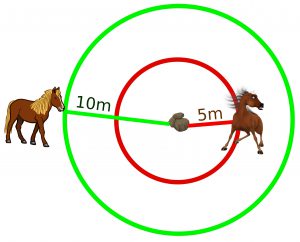I’d like to introduce five of our Strategies for Success that we follow when we start working with horses on obstacles or anything new and unknown.
- We build it in the groundwork, then ride it in the saddle.
- We never force a horse to go on, over or though something they’re scared of. We do go forward when the horse is in release and following our focus.
- Find ground zero. This is the position, proximity to an obstacle, or a maneuver that we know the horse can achieve. We can always start successfully from our ground zero point.
- We define success as, “anytime the horse tries for us,” and reward and encourage our horse when he tries.
- We allow the horse the time he needs to investigate the obstacle before we continue to ask him forward.
In this article, we’re going to focus on #3. You’ll need to read Part 1 and Part 2 first.
When a horse is fearful of something, there will be a certain distance he will be comfortable standing away from it. It likely won’t matter what direction you approach it from, that distance will be the same.
In the groundwork or riding, you’ll notice that the closer you get to the fearful object – we’ll call it an obstacle – the slower your horse will go until he stops. This is entirely natural. Consider that, in the prey animal’s mind, anything unknown is potentially lethal.
There will always be an invisible line beyond which the horse may attempt to leave. He might back up or move sideways. If you’re on the safe side of the line, or on the line itself, your horse will be able to stop. At this point you’ll be able to ask him to release. When he does, you can ask for another step forward. You’ll work through this until you’re up to the obstacle. This might take several sessions over several days. That’s the best way to do it – don’t force it or you’ll compromise trust. We touched on that in Part 2.
Until the horse has released to the pressure of the obstacle at the point he can stop, do not ask him to go further. Ask him forward only once he’s in release at that point. This is tough for many folks because we get greedy. We want our horse to do it now. Be patient though, if you stay in a supportive role, the horse will come to depend on you as the answer to stress and pressure for all obstacles, not just this one.
Let’s dig into this a bit deeper, referencing the image. A horse will stop at the point where his ability to handle the pressure presented to him hits a limit. If we push him past this limit, then he’ll resort to instinctive behaviors: flee, freeze or fight.
There are 2 things that will get the horse beyond this point:
- You asking him to release and go forward with you (you’ll see that in this video).
- His own curiosity. This will eventually happen and he’ll go forward on his own. I see this often on items like stuffed animals or hides.
In the image, the horse on the left is comfortable stopping 10m away from the scary rock. The horse on the right has hit the limit of what he considers safe, and is taking action to save his life.
I like to call any point on the green circle our Ground Zero Point. This is the distance from the obstacle that the horse can always stand and not try to escape. Our job then, is to make that green circle smaller and smaller, until it’s gone…without hitting the red circle.
Our first job then, is to find where that green circle is. Let’s use trailer loading as an example. The obstacle: standing quietly in the trailer. We lead our horse up to the trailer. At some point he pulls back and turns away. This is the indicator that we’ve crossed the red line. So we start again. This time, we’re more attentive and notice when our horse starts to become tense. His head might go up, his jaw tighten, etc. At this point, we stop.
If our horse can stand with us, we’re on the green line. If not, back up a bit. We find where that spot is that our horse can stand without moving or trying to leave.
Once we’ve found that, we ask the horse to release (again, this is letting go of tension and following your focus). Then, we clearly focus forward and ask the horse to come with us. Once he takes a step or two, stop. You’ll likely notice that he becomes tense again. Now, we’re in the space between the red and green circles – this is where we need to play. This is the zone – as with all pressure – where your horse is not comfortable but still willing to trust you.
Stay in that spot for a bit and ask your horse to release. When he does you might try another step forward OR you might leave. We don’t want to push things beyond his ability, however we do need to make that green circle smaller. When you use this tactic, you’ll notice that the next time you lead your horse up to the trailer, he can stand quietly, closer to it.
Thus, you’ve established a new Ground Zero Point. To see an example of this as it pertains to the trailer, watch this video.
You will be able to get your horse up to any scary thing in a quiet supportive way by following these steps. The great thing is that the horse will learn to depend on you for anything scary, because you’ve kept the experience entirely positive.
And, each time he tries, we praise him for it…which takes us to our next article!
Scott Phillips
November, 2018
